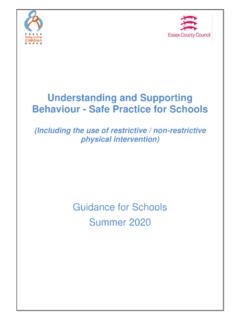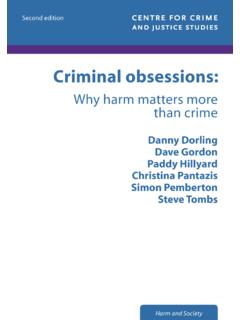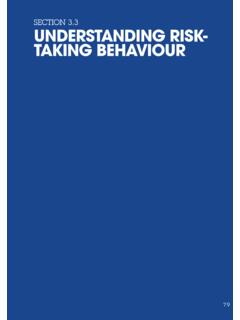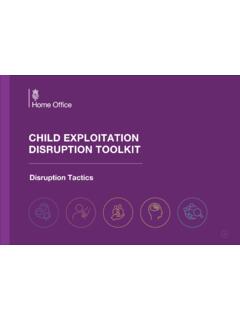Transcription of Harmful Sexual ehaviour Practitioner Toolkit - KSCP
1 Harmful Sexual Behaviour Practitioner Toolkit Version Control: 1. Date: January 2020. Contents Introduction Using the Interventions Responding to disclosures Ensuring a safe environment for delivering interventions Definition of Harmful Sexual Behaviour Brook Traffic Light Tool KSCB website information on Harmful Sexual Behaviour Other available interventions for Harmful Sexual Behaviour Kirklees Harmful Sexual Behaviour Pathway (Initial Screening). Kirklees Harmful Sexual Behaviour Pathway (Strategy Discussion considerations). Kirklees Harmful Sexual Behaviour Pathway (Guidance for Single Assessments).
2 Do's and Don'ts for professionals when working with young people who display Harmful Sexual Behaviour 10 Helpful Intervention Tips' when working with young people with young people with Harmful Sexual Behaviour The Tools Getting to Know You Getting to Know You Healthy Friendships / Relationships Power and Control / Respect Wheels How to mend a broken heart Exploring relationships Public vs. Private Pants Pants 2. Be Share Aware Lesson 1 Alex Pants ( ). Changes and Choices Changes and Choices 2. Managing Feelings You, Me and Us Self Esteem Negatives and Positive Words about me Gratitude Journal Three Good Things Two Version Control: 1.
3 Date: February 2020. Contents 2. Consent Consent scenarios Sex without consent I suppose that's rape Sex without consent I suppose that's rape 2. Victim Awareness Ripple Effect What if I re-offend? Excuses . Consequences If I get into trouble again? Cost Benefit Analysis Sex Education Contraception Accessing Services Sexual Words Advice for parents of children displaying Harmful Sexual Behaviour Helpful messages for worried parents Family Safety Plan Local Support and Resources Available Useful Websites Three Introduction Welcome to the KSCP Harmful Sexual Behaviour (HSB) Practitioners Toolkit .
4 This Toolkit has been developed to support a wide range of professionals working with children, young people and families. It was recognised that there was a need to collate useful interventions and advice for professionals who are working in the area of HSB. Many children display HSB at the lower end of seriousness which does not progress through a criminal charge or sentence. Without the specialist intervention from the Youth Offending Team these children are missing out on a targeted consistent response from other workers. It is hoped that this Toolkit increases the confidence of professionals working in education, social work and family support as well as a wide range of others who are doing direct work with young people and families.
5 Using the Interventions All the intervention sheets have a suggested age / understanding range and whether the intervention is suitable for group work or more suited to being completed on an individual basis. Some of the resources will link to websites which have further resources, in particular film resources. Judgement should be used in individual cases regarding the suitability and relevance of each sheet for a young person / group of young people. Not all sheets need to be completed an assessment should be completed to determine which areas of work need to be looked at.
6 This assessment may be at an Early Support, Child in Need or Child Protection level. Responding to disclosures It is important to remind young people of where they can go to talk or get help after your session. Remind the children of whom they can talk to and that you are available should they wish to talk about the issues raised by the intervention. As a result of the content of the intervention, a child might disclose that they are suffering from abuse, have done previously, or are aware of it happening to others. Any disclosure of abuse should be treated as a potential child protection concern, and reported to following your internal safeguarding procedures.
7 Points to remember when listening to and dealing with disclosure: Actively listen, do not look shocked or disbelieving. Stay calm. Take what they are saying seriously. Do not ask leading questions. Reassure them that they are doing the right thing. Do not promise to keep secrets. Tell them that you will have to share this information. Explain what will happen next. Be familiar with your child protection procedures. Report to the Designated Safeguarding Lead as soon as possible. Record the information as quickly as possible Sign and date everything you record. Get support for yourself from the Designated Safeguarding Lead or call Kirklees Duty and Advice 01484.
8 414960. Four Ensuring a safe environment for delivering interventions A safe learning environment helps the young person / young people feel comfortable with sharing their ideas, values and atti- tudes without attracting negative feedback, and will help you to manage discussions on sensitive issues confidently. It is good practice for you to: work with children and young people to establish ground rules about how they will behave in discussion: - Everyone has the right to be heard and respected. - We will use language that won't offend or upset other people. - We will use the correct terms, and if we don't know them, we'll ask the teacher.
9 - We will comment on what was said, not the person who said it. - We won't share our own, or our friends', personal experiences. - We won't put anyone on the spot and we have a right to pass. - We won't judge or make assumptions about anyone. offer opportunities for young people to discuss issues in small groups as well as sharing views with the class make boxes available in which young people can place anonymous questions or concerns, to avoid having to voice them in front of the rest of the group provide balanced information and differing views to help young people clarify their own opinions (making clear that behav- iours such as discrimination and bullying are never acceptable in any form).
10 Be sensitive to the needs and experiences of individuals some young people may have direct experience of some of the issues distance the learning from young people when working in a group setting to discourage personal disclosures in the group, avoid creating an emotional response that will block learning and to allow learners to consider the content objectively. Distanc- ing can be achieved through the use of case studies, examples and questioning which focus on the choices and actions of ficti- tious characters, rather than the young person themselves always work within your organisations policies on safeguarding and confidentiality make young people aware of sources of support, and how to access it both inside and outside the school.








